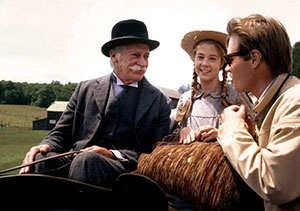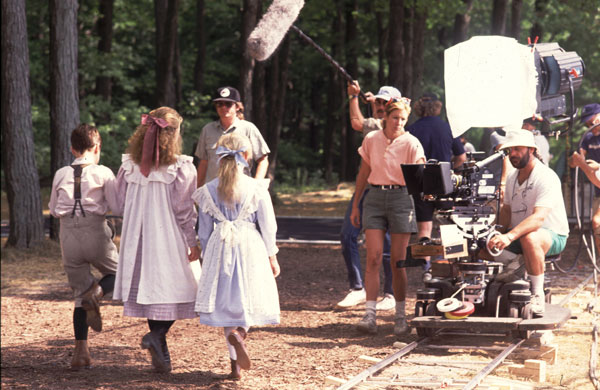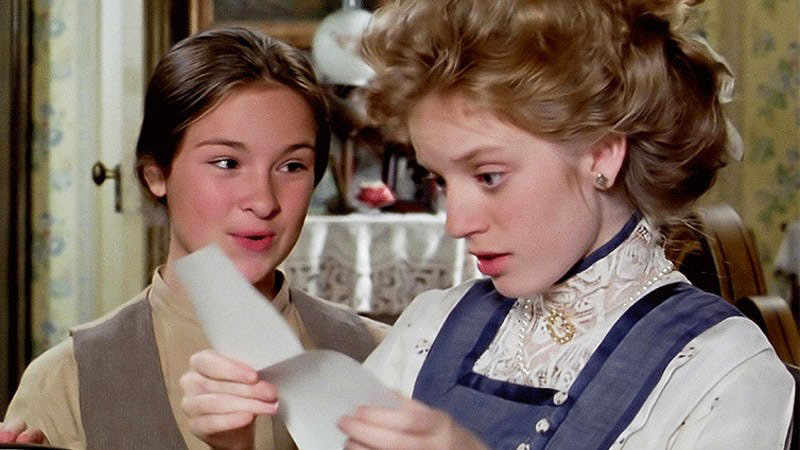Producer Kevin Sullivan strolled beneath the tall cool pine trees and through the lush fields of the Uxbridge property that used to be the setting of his landmark series Road to Avonlea. The set of the early 20th-century village was long gone and the laughter of the King Cousins as they rambled across the field was only a memory; but Sullivan could still feel the powerful presence of Avonlea in the idle of the summer’s day.
“I find it remarkable to come back here twenty years later and find so many aspects, so many elements of this location that has not changed,” he mused. “It gives one a sense of timeliness; a sense of passing for people who have come and gone.”
Sullivan paused to appreciate an old fence near a lane where Sara and Felicity once ran joyfully one crisp autumn afternoon. “Look at this fence. It’s probably been here a hundred years. Who knows, maybe it will stay another hundred years.”
The producer was revisiting the Uxbridge haunt to promote the DVD re-release of Road to Avonlea’s first season. It was twenty years ago when viewers first saw Sara Stanley begin her journey on the Road to Avonlea; and at the time, nobody knew where the road would lead or what awaited them beyond what Montgomery’s Anne Shirley called “the bend in the road.” For Sullivan, his road didn’t originally lead to Avonlea, or even film making. His journey was on another path all together.
Kevin Sullivan was born in Toronto on May 28, 1955. During his childhood, he would listen to his Father, Aunts and Uncles tell stories about their lives during the era at the turn-of-the-century. (Sullivan, 12-08). Although he was a fairly literate child, he never read Anne of Green Gables. Instead, his grade five teacher read the classic work to him. “It left a very strong visual impression on me,” he remembered. “Everyone else seemed turned on by the story, but I was left with the visuals (Kareda, 14).”
Interestingly, Sullivan’s initial career choice wasn’t in film. In the mid-70’s, Sullivan attended the University of Toronto with hopes of qualifying for medical school. On one occasion, the studious 19-year old Sullivan turned down a ski trip to spend the weekend “calculating the surface area of a glazed doughnut (Dwyer, 58).”
Before becoming a director, Sullivan was a bus tour guide, a bartender and emptied vats of boiling oil at Kentucky Fried Chicken.
Sullivan’s interest in drama lured him to the university’s Hart House Theatre where he worked on-stage and behind the scenes. By the time he received an honors degree in Biology in 1978, Sullivan decided to forgo his medical goals and pursue a career in film. "I realized I didn't want to make a career in what I studied,” he said. “I had always been interested in movies. I thought well, there are all these people making films and I bet I could make a film (Kelly, 1990, T.42).”
At the age of 24, Sullivan and his business partner (and future wife), Trudy Grant, founded Sullivan Entertainment and started his filmmaking career with a Hans Christian Anderson Christmas special. “I put together a half hour film called The Fir Tree,” he remembered. “(I) shot it, cut it myself and learned the whole process of production from one end to the other by the school of hard knocks (ibid)." This was followed by the docu-drama Kreighoff (1979), Megan Carey (1980) and his first feature film, The Wild Pony (1982).
Sullivan travelled extensively in Europe and studied various paintings. He particularly favored Rembrandt for the artist's use of lighting. (Kareda, 14). These artistic interests greatly influenced Sullivan's use of composition and lighting in his films.
In 1983, the Canadian federal government committed $265 million over five years to expand Telefilm Canada and establish the Broadcast Fund. The Fund invested in privately produced weekly series miniseries and specials popular in Canada (Adilman, 93, J.3). This allowed TV programs such as Beachcombers and The Littlest Hobo to win national audiences and broadcasters outside the country.
The Broadcast Fund also provided the opportunity and resources necessary for Sullivan to create a Canadian mini-series. "I know that there was a niche in television which was high quality family production, that wasn't your Saturday morning kiddie stuff,” Sullivan said, “something that would appeal to a wide group of people and that was produced on a high budget. (Kelly, 1990, T.42)." He found this niche by planning to create an adaptation of Lucy Maud Montgomery’s Anne of Green Gables.
Who Has the Rights?
Montgomery signed a contract with L.C. Page Co. in 1928, stating that all copyrights reverted back to her descendants after she died. Sullivan discovered the contract while doing research for the mini-series and notified the family, who were unaware for decades that they had legal rights to the author’s works (CBC Archives).
At first, Sullivan had a hard time reconnecting with the work. "Montgomery made such a great impression when I was in grade 5, but the feelings were almost impenetrable to me as an adult when I reread her books. It was almost like looking at an antique, and I was frankly disappointed. But when I dug deeper, I found those emotions again (Hart, 3)."
In February 1984, Sullivan purchased the rights to Anne of Green Gables for $425,000 from the heirs of Lucy Maud Montgomery. The family’s lawyer, Marian Hebb, prepared the contract requiring Sullivan to pay “10 percent of the net profits in perpetuity based on the use of all rights (Ross, A.1).” This included net profits from all adaptations.
 Anne of Green Gables aired December 1, 1985 on the Canadian Broadcasting Company to 5.6 million viewers, becoming the highest rated mini-series in Canadian television history. The tremendous critical and commercial success led to Anne of Green Gables: The Sequel (1987), based on Montgomery’s subsequent Anne novels. Sullivan was disappointed when The Disney Channel renamed the sequel ‘Anne of Avonlea,’ sparking a creative conflict that would continue for years.
Anne of Green Gables aired December 1, 1985 on the Canadian Broadcasting Company to 5.6 million viewers, becoming the highest rated mini-series in Canadian television history. The tremendous critical and commercial success led to Anne of Green Gables: The Sequel (1987), based on Montgomery’s subsequent Anne novels. Sullivan was disappointed when The Disney Channel renamed the sequel ‘Anne of Avonlea,’ sparking a creative conflict that would continue for years.
In 1987, Ivan Fecan was appointed director of CBC television programming “with a mandate from then vice-president Denis Harvey to shake things up (Atherton, 93, E.4).” Around this time, only 78 percent of television content in prime time was Canadian. Fecan was committed to changing this trend by increasing Canadian content and popularizing Canadian drama on CBC. This new direction by CBC was critical for the success of Road to Avonlea.
 The following year, Sullivan produced the made-for-TV movie Lantern Hill, based on Montgomery’s novel ‘Jane of Lantern Hill,’ about a 12-year-old girl (Mairon Bennett) who goes to live with her grandmother on P.E.I. After the shooting wrapped, Sullivan insisted that he was finished with Montgomery based projects. "I can remember being asked whether I wanted to do an Anne of Green Gables series," Sullivan recalled, "and I said absolutely not (Boone, 93, E.6)."
The following year, Sullivan produced the made-for-TV movie Lantern Hill, based on Montgomery’s novel ‘Jane of Lantern Hill,’ about a 12-year-old girl (Mairon Bennett) who goes to live with her grandmother on P.E.I. After the shooting wrapped, Sullivan insisted that he was finished with Montgomery based projects. "I can remember being asked whether I wanted to do an Anne of Green Gables series," Sullivan recalled, "and I said absolutely not (Boone, 93, E.6)."
Lantern Hill featured future Road to Avonlea actors Sarah Polley, Zachary Bennett and Mairon Bennett. Mairon and Sarah became friends on the set. Between shoots, the pair would interview crew members for fun (Blackadar, D.21).
Sullivan wanted to move beyond the works of Montgomery and was not originally keen on producing a television series based on her works. "There was a company which wanted us to make Anne into an ongoing fictional series similar to Little House on the Prairie," he said. According to the Gazette, Sullivan respected Montgomery’s “talent and the place it holds in the hearts of Canadians too much to turn it into formula television. (Wesley, T.8)”
However, the networks and loyal audiences pressured Sullivan for more. "I feel caught in the same way Montgomery was when she wanted to stop writing about Anne and Avonlea,” he said. “Her publisher insisted she continue. So, she did. (Adilman, F.1)."
Sullivan relented and agreed to co-produce a 13-part hour long series based once again on the Montgomery works. This time he would not be returning as a director, but as an executive producer. There were considerations for creating a continuing series for Anne of Green Gables, but Sullivan felt that they “might have exhausted the dramatic possibilities” of Anne Shirley’s story (Walker, S.4); and according to one Toronto Star article: Anne was not very interesting once she had grown up (Bawden, SW.4).
"The audience response to `Anne of Green Gables' was so incredible," he says, "that people kept asking us to do more. I feel I have said what I wanted to with Anne, so I suggested compiling some of Montgomery's other stories and novels into the `Avonlea' script (Hart, 3)."
While exploring Montgomery’s treasure chest of literary works, Sullivan stumbled upon The Story Girl, The Golden Road, Chronicles of Avonlea, and Further Chronicles of Avonlea. “There’s a ton of stuff there,” Sullivan noted, “and a whole roster of character(s) we’ve not seen and whom most people have probably not read about (Adilamn, F.1).”
He would later describe the series as a “montage of pieces” from Montgomery’s novel. “She was very good at creating atmosphere and character,”' Sullivan said of the author. “But she was kind of lousy on story, to be honest (Boone, D.1).” He also felt that her works after Anne of Green Gables were “uneven” and “soapish as far as plot went (Bawden, SW.4).”
Sullivan signed an agreement with the Montgomery heirs in 1989 for the rights to the new series. With the rights obtained, he began negotiations with CBC and The Disney Channel as well as broadcasters in England and Australia to produce the series. The task was to persuade financial backers that the new series, based on a relatively unknown heroine, could work on prime time television.
It was decided that the town The Story Girl and Golden Road were based in, Carlisle, would be changed to Avonlea “for the sake of continuity (walker, s.4).” This would allow the principle characters to interact with characters from Anne of Green Gables, and thus, pull in the audience from the immensely successful television mini-series.
Sullivan was juggling several productions in 1989. In addition to the series, he was producing Looking for Miracles, based on the memoirs of A.E. Hotchner about a 16-year old boy who reunites with his younger brother at summer camp. The principal roles were played by future Road to Avonlea actors Greg Spottiswood and Zachary Bennett.
At the time, CBC only had enough money to produce one hour long drama and two programs were in competition: ENG, based on life in a television newsroom and Road to Avonlea. Although Fecan would later regret letting ENG get away, the network ultimately chose Road to Avonlea (Monchuk, B.10). Despite CBC’s commitment to the series, the network could only pay part of the $15 million total budget ($1.2 million per episode) required to produce the show (in addition to Telefilm Canada’s 2.5 million investment).
At first, Sullivan was reluctant to accept financial support from The Disney Channel, fearing they would try to “Disney-fy” the series. He ultimately relented, realizing that Disney’s financial investment of $8 million was critical to achieve the standard of quality he envisioned. Although there are some differences of interpretation - Disney tends toward ''sentimentality,” Sullivan noted. “The three make ''a happy team” (Nicholls, C.5).
Road to Avonlea was scheduled during the CBC Family Hour Sunday nights at 7pm. CBC initially created the Family Hour as an answer to the The Walt Disney Show which had earned high ratings since the 1950’s. Fecan, believed that “CBC could popularize Canadian history and Canadian values in the same way Disney did with Davy Crockett and Pollyanna (Atherton, 1992, C.5).” Although The Family Hour began as a vehicle for various independent productions, Road to Avonlea would nearly dominate the show for years to come.
With the series properly financed, Sullivan now focused his attention on adapting the series for television. The once medical school hopeful-turned film director—who vowed never to create another Montgomery based production—was about to journey down Montgomery’s literary road again. It would lead him to the pastoral beauty of the Uxbridge property with its “sense of passing for people who have come and gone”—and where only a dozen miles away and almost a century before, Montgomery penned her novel, The Story Girl.





Leave a comment
Login to post a comment
Post comment as a guest